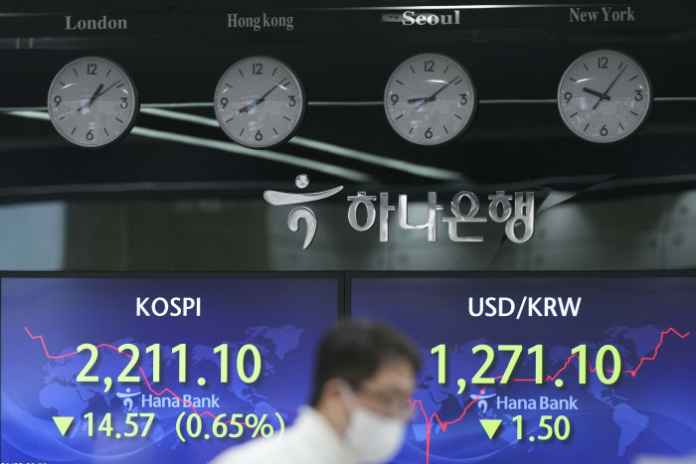A currency trader walks by the screens showing the Korea Composite Stock Price Index (KOSPI), left, and the foreign exchange rate between U.S. dollar and South Korean won at a foreign exchange dealing room in Seoul, South Korea, Tuesday, Jan. 3, 2023. Asian stock markets were mixed Tuesday ahead of updates on U.S. employment amid fears of a possible global recession. (AP Photo/Lee Jin-man)
BEIJING – Asian stock markets were mixed Tuesday ahead of updates on U.S. employment amid fears of a possible global recession.
Shanghai and Hong Kong gained. Seoul and Sydney declined. Oil prices fell.
Coming off a year of big declines for major stock markets, traders worry the Federal Reserve and other central banks that have raised interest rates repeatedly to cool inflation might be willing to push the world into recession.
Inflation might “remain far north of 3% by the end of 2023, simply too high for central bank comfort,” said Stephen Innes of SPI Asset Management in a report.
The Shanghai Composite Index gained 0.2% to 3,094.12 and the Hang Seng in Hong Kong added 0.6% to 19,906.65. Japanese markets were closed for a holiday.
Seoul’s Kospi shed 0.8% to 2,208.36 after South Korea’s 2022 exports fell 9.5% from the previous year and the country recorded its biggest trade deficit ever.
Sydney’s S&P-ASX 200 lost 1.6% to 6,927.20 after Australian house prices fell 1.1% and an index of manufacturing activity decline. Singapore declined while Jakarta advanced. New Zealand markets were closed for a holiday.
This week’s most closely watched data points are notes from the Fed’s latest meeting due to be released Thursday. That will give traders an update on the U.S. central bank’s thinking about the possible need for more rate hikes.
It will be followed Friday by U.S. employment data.
Forecasters expect monthly job gains to decline in December, which they hope might encourage the Fed to dial back plans for more rate hikes. But the Fed has a “clear focus on keeping inflation under check,” which “could still leave pricing data as the key driver of market moves,” Yeap Jun Rong of IG said in a report.
Traders also are looking ahead to corporate earnings reports in mid-January.
Global central banks are trying to extinguish inflation that is at multi-decade highs in many countries. It has been worsened by Russia’s invasion of Ukraine, which disrupted commodity markets and caused oil and wheat prices to spike.
U.S. financial markets were closed Monday for a holiday after Wall Street’s benchmark S&P 500 index ended 2022 down 19.4%, its biggest decline since the 2008 financial crisis. It lost $8.2 trillion in stock value, according to S&P Dow Jones Indices.
Market benchmarks in Germany and France closed higher Monday.
The Fed’s key lending rate stands at a range of 4.25% to 4.5%, up from close to zero after seven increases last year. The U.S. central bank forecasts it will reach a range of 5% to 5.25% by late 2023, with no rate cut before 2024.
In energy markets, benchmark U.S. crude lost 20 cents to $80.06 per barrel in electronic trading on the New York Mercantile Exchange. The contract rose $1.86 on Monday to $80.26. Brent crude, the price basis for international oil trading, shed 26 cents to $85.65 per barrel in London. It added $2.45 the previous session to $85.91.
The dollar declined to 130.17 yen from Monday’s 130.80 yen. The euro edged down to $1.0667 from $1.0700.



